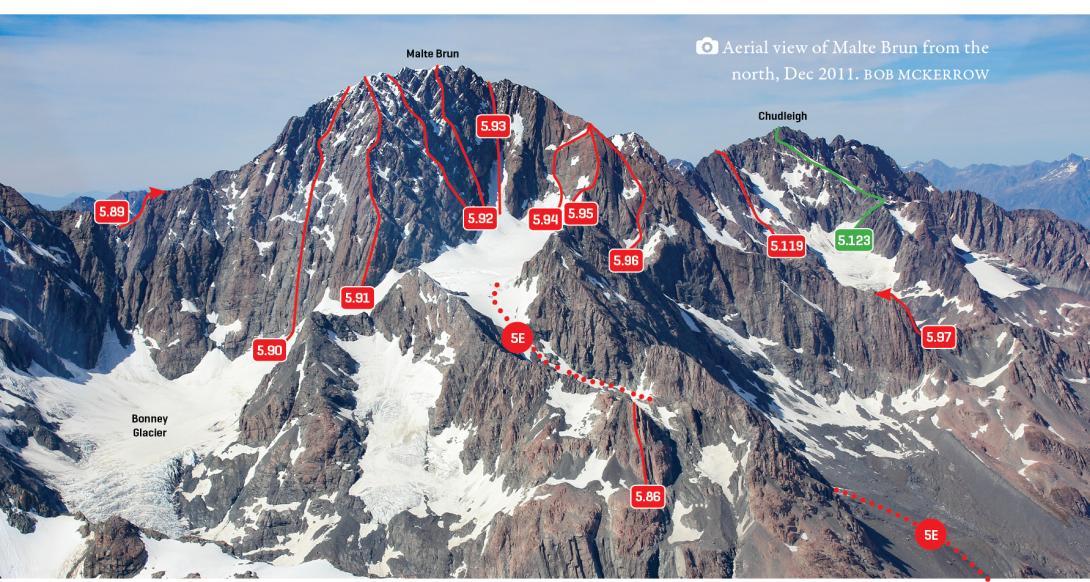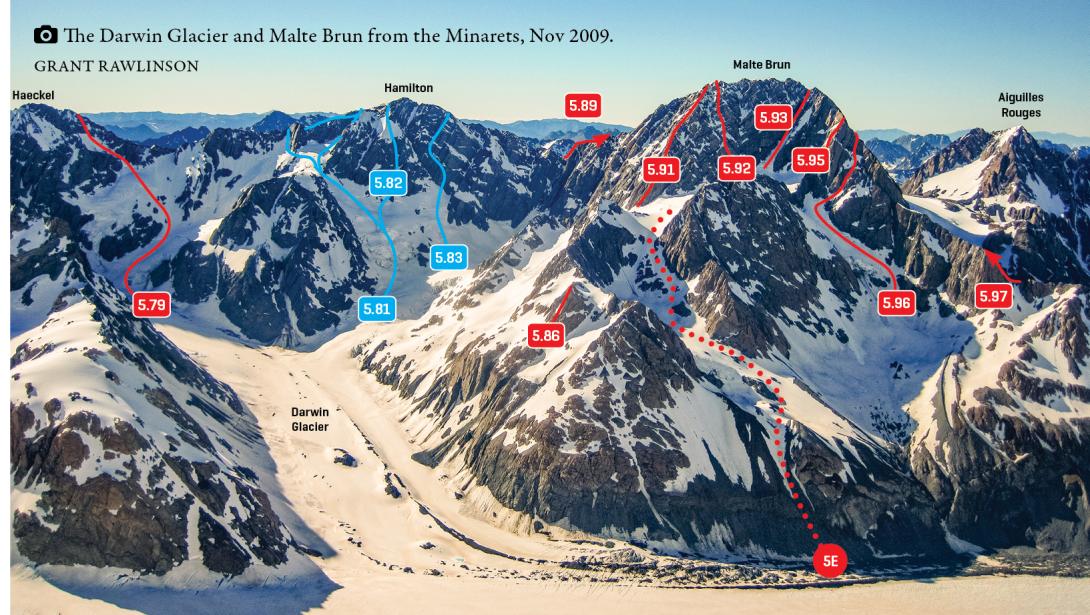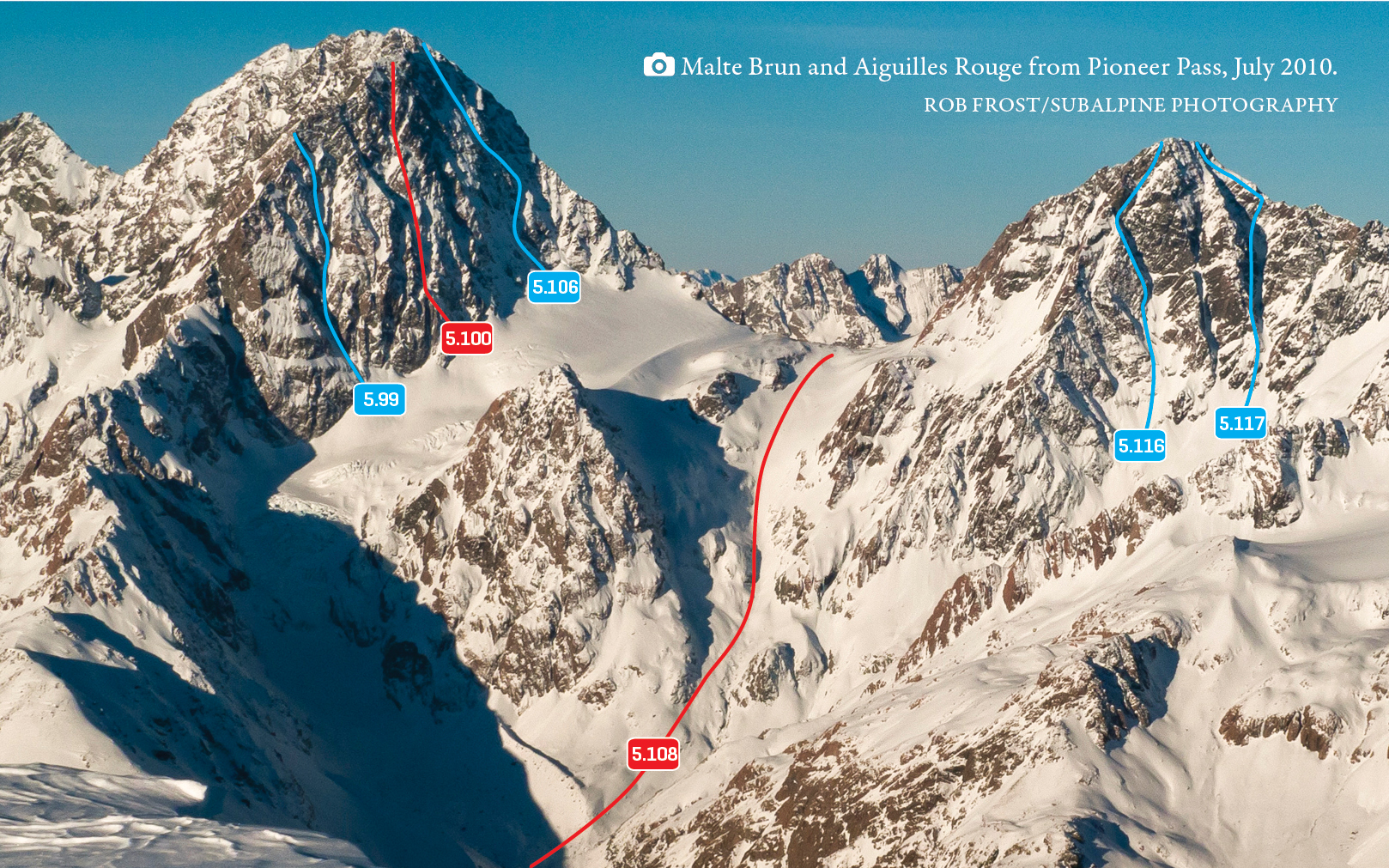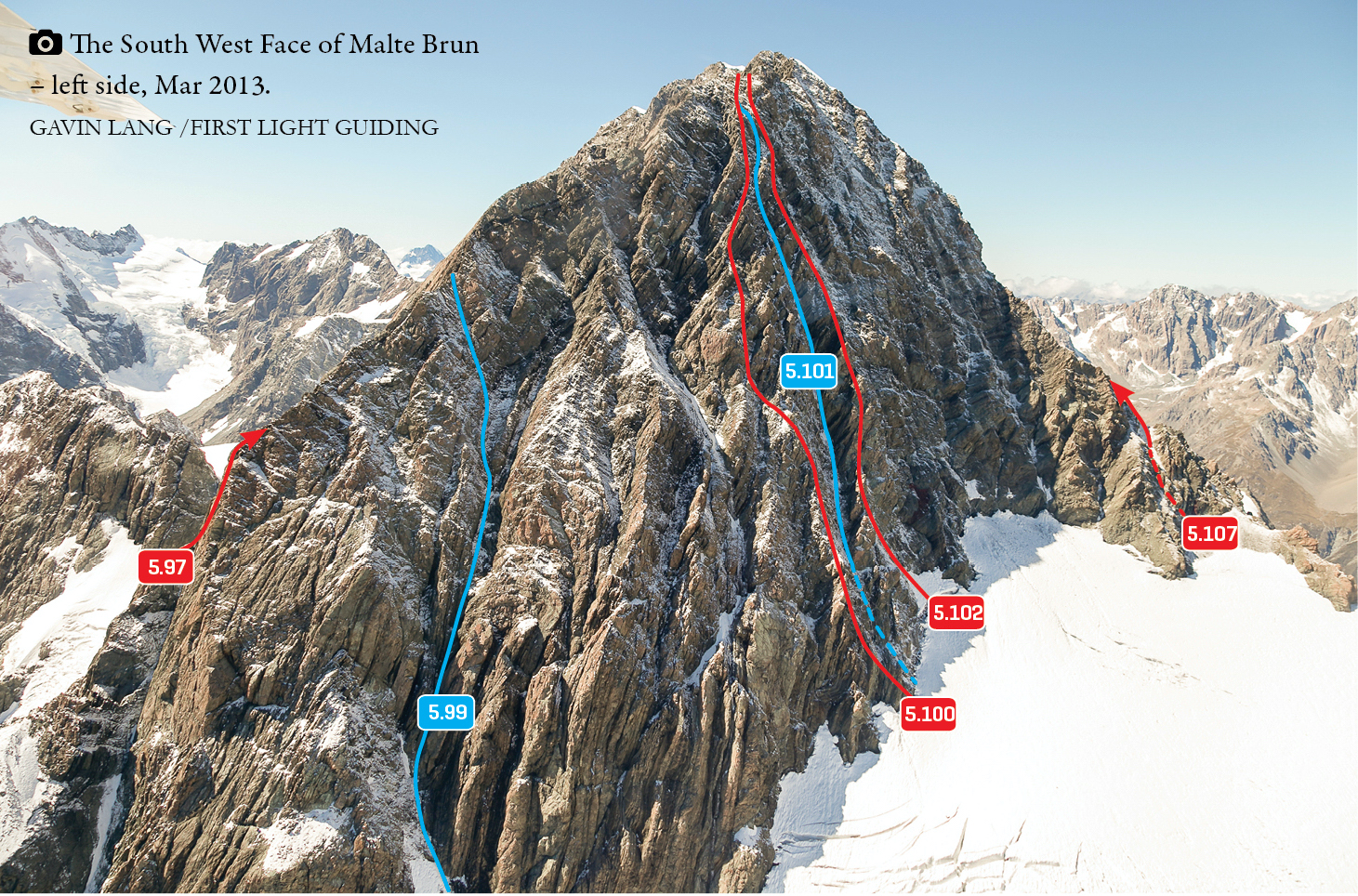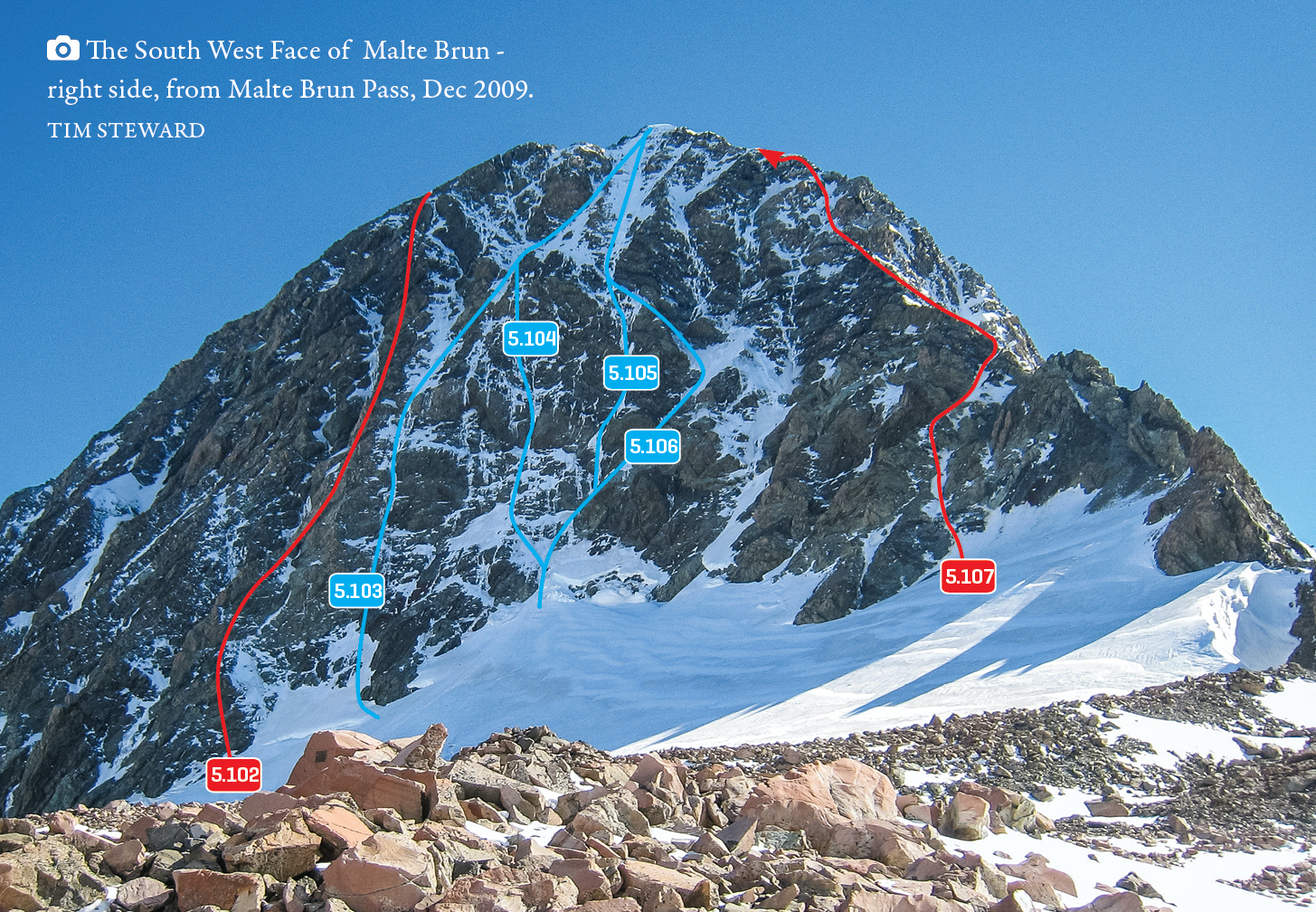Malte Brun is a grand mountain that has been seducing mountaineers for more than 120 years. The north and west aspects offer excellent, long climbs on mostly good rock, and the South West Face hosts a range of ice/snow climbs.
Most routes on Malte Brun begin on the Bonney Glacier. The upper Bonney can be accessed either up the Darwin Glacier and lower Bonney (there is sometimes a marginal route through the icefalls until New Year), or more reliably up the Turnbull Glacier (use ledges on the true left to get around the rock step).
The Malte Brun Glacier should not be used as an access route to the Bonney – it has almost completely disappeared, and there is now an unpleasant 3-pitch climb on terrible rock to reach the col at the head of the glacier.
Places
| Type | Name | Alert |
|---|---|---|
| Face | South West Face | |
| Face | East Face |
Routes
| Reference | Title | Grade | Length | Pro | Quality | Alert | Operations |
|---|---|---|---|---|---|---|---|
| 5.89 | 5.89North East Ridge, V,3 | V,3 | 0m | ||||
|
Descend the South West Ridge of Mt Hamilton to a narrow rubbly notch (the Hamilton-Malte Brun col). Alternatively, ascend directly to the col via a narrow couloir from the Bonney Glacier. From the col, climb up a steep slab for 100m, then on up the ridge, which rises in a series of short steps of good rock.
|
|||||||
| Multi Sport , V,5,18 | V,5,18 | 700m | |||||
|
Up prominent a rock rib to the right of the gully on the north face from the Bonney Glacier, 15-20 pitches. The first two thirds of the route is on fantastic rock. The last third is quite chossy. The first ascent was done with bivvy gear and the team descended the Bonney Rib.
|
|||||||
| Malte Brun’s Treasure Box, V,5,18 | V,5,18 | 700m | |||||
|
This climb is a variation on Multi Sport and shares the same first 7 pitches. The climb is 16 full pitches at which point the route meets the North East Ridge at 3000m. From here to the summit a lot of chossy Jenga tower ridge line traversing is required. The first ascent was done with bivvy gear and descent was down the Bonney Rib.
|
|||||||
| 5.90 | 5.90North Face, V,3 | V,3 | 0m | ||||
|
From the lower Bonney Glacier, ascend the ribs and slabs of good rock between the North East and North Ridges. There’s plenty of room for variations.
|
|||||||
| 5.91 | 5.91North Ridge, V,3+,10 | V,3+,10 | 0m | ||||
|
Similar in difficulty to the Bonney Rib—combining these routes would make an excellent traverse of Malte Brun. Most parties begin from the Bonney Glacier just above the upper icefall, but there is wide scope for variations. The first 25m involves delicate climbing on rounded holds, where the glacier has retreated in recent years. Above this the rock is good and the holds more positive (sustained climbing), with a short cheval section higher up. Highly recommended.
|
|||||||
| 5.92 | 5.92North West Face, V,3+,10 | V,3+,10 | 0m | ||||
|
The scene of Tom Fyfe’s remarkable 1894 solo climb. Fyfe’s route ascends to the left of a shallow couloir in the centre of the face. Other routes ascend to the right of the couloir while some variations keep closer to the North Ridge. Sustained climbing on generally good rock.
|
|||||||
| 5.93 | 5.93The Big Couloir, V,3 | V,3 | 0m | ||||
|
From the névé of the Bonney Glacier, ascend the prominent snow and ice couloir to within 200m of the summit. Not recommended, especially in late summer, as some of the worst rock on Malte becomes exposed in the upper couloir. This is not the couloir famously glissaded by Fyfe, which is smaller and further left.
|
|||||||
| 5.94 | 5.94Bonney Headwall, V,4,14 | V,4,14 | 0m | ||||
|
The Bonney Headwall is a good late season option for the West Ridge when access to the base of the Bonney Rib is cut off.
|
|||||||
| 5.95 | 5.95Bonney Rib, V,3+,11 | V,3+,11 | 0m | ||||
|
Highly recommended. Now that the Yak Route has become frequently difficult to access, the Bonney Rib is the best way to sample the delights of Malte Brun’s famous cheval – a spectacularly exposed and narrow section of solid red rock. Many parties start this climb from a good bivvy/camp spot on the col between the Bonney and Malte Brun Glaciers, below the prominent gendarmes at the base of the Bonney Rib.
|
|||||||
| Biophilia, IV,4,14 | IV,4,14 | 421m | |||||
|
An objectively 'safe' rock route with compact featured slabs. A great way to access the West Ridge and descend. Reached from the top of the Malte Brun Glacier either at the left hand edge (grade 16), or more easily up the right hand ramp (see white lines on photo). Rap stations (pitons and nuts) have been established at roughly 60m length on ascent. The route was first attempted up to pitch 4.5 in mountain boots in 2015, and retreat was due to lack of gear. The first complete ascent was done with rock shoes in optimal climbing conditions, switching to approach shoes at the apex of the West Ridge. BYO rap cord and expect to replace it completely. Top of the access gully: Bivvy site (there are many others):
Head up from obvious start to join weakness. Chimney moves are the crux
Follow weakness/ crack then head left to Arete.
Continue up arete to large ledge, then follow right trending cracks up to belay ledge.
Step up to tiny roof, step right, then follow red rock keeping approx 10m right of grey corner.
Continue up 12m then cross left over grey corner onto new red rib. Steep and fun. Best pitch **
25m to ledge, ignore existing rap station 10m out left. Plug in .5 cam into grey roof, then step onto red prow.
Easy scrambling to apex of West Ridge. Some existing anchors/ bollards in place at approx 25m intervals. |
|||||||
| 5.96 | 5.96Yak Route, V,4,14 | V,4,14 | 0m | ||||
|
This has long been a popular route, as it provided the least technical way to the upper West Ridge. However, over the last few years there has been rampant recession of the Malte Brun Glacier, which has exposed more difficult rock. By late summer there can also be sections of steep, hard, old basal ice that require good mountaineering skills to negotiate.
|
|||||||
| 5.97 | 5.97West Ridge, V,4+,12 | V,4+,12 | 0m | ||||
|
A very long climb, recently made slightly more difficult due to rockfall. The lower ridge is straightforward, but some parties have opted to avoid it by sidling on scree on the north side of the ridge, climbing back up to regain the ridge at a col at 2250m. From there, follow the ridge on good rock. At one point, a large chunk of the ridge has fallen off, leaving a notch with a very steep, smooth pillar of rock on the uphill (eastern) side. From the notch, traverse horizontally on the left (north) side – about grade 12, but very exposed – to bypass the difficult rock, then climb up to regain the ridge. The ridge has some sustained sections of climbing before it eases off. Cross the cheval and continue another 200m higher to the summit.
|
|||||||
| Maxi the Taxi, I,4+,16 | I,4+,16 | 0m | |||||
|
A pillar on the north side of the lower west ridge provides excellent climbing.
|
|||||||
